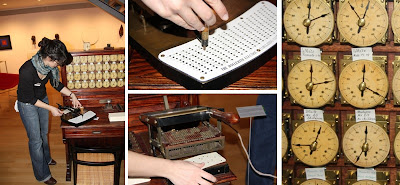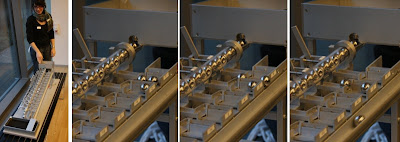Instead of covering the history of calculating machines in the DSD lecture, we took the train and went to the Arithmeum in Bonn to the see the artefacts live and to play with some of them.
We started with early means for counting and record keeping. The tokens and early writings did not use numbers as abstract concepts, rather as representatives of concrete objects – this is very inspiring, especially from a tangible interaction point of view. The knots, as used in south America, show impressively how the tools for calculation have to fit the context people live in. Interestingly all these artefacts highliht how the ability to calculate and store information is related to the ability to do trade – quite a good motivation for the setup we have in Essen business studies and computer science within one faculty.
I was again impressed by the ingenuity by the early inventers of calculating tools and machines. There is an interesting separation between calculating tools and machines – the first ones require the user to take care of the carry and the second do it by themselves. We tried out replicas of Napier’s calculating tool and Schickard’s calculating machine.
The beauty and the mechanical precision required of those early machines is impressive. These prototypes (most of them took years and massive funds to be built complete) can teach us something for research today. These inventors had visions and the will to get it implemented, even without a clear application or business model in mind. They were excited by the creating of systems than can do things, machines could not do before. From the professions of the inventors (e.g. Philipp Matthäus Hahn was a clergyman) it becomes apparent that at these times some considered religion and calculation as closely related – which to mondern understanding is very very alien.

Seeing the Hollerith machine that was used for the US census more than 100 years ago can teach you a lot about data processing. Punch cards, electrical reading and electrical counters (using mainly relays) were the basis for this technology. Looking at the labels on the counters showed that the US has a long tradition in collecting data that is after some time is not seen as political correct 😉
 Having learned binary calculations during the DSD course it was nice to see a machine that did binary additions, using small steel balls and gravity. On each place (1,2,4,8, …) there is space for one ball. If a second one comes to this place one moves up to the next place (carry) and one is discarded. This is implemented with very simple mechanics and the working prototype (recently build) is based on designs of Schickard (but he never built – if I am correct).
Having learned binary calculations during the DSD course it was nice to see a machine that did binary additions, using small steel balls and gravity. On each place (1,2,4,8, …) there is space for one ball. If a second one comes to this place one moves up to the next place (carry) and one is discarded. This is implemented with very simple mechanics and the working prototype (recently build) is based on designs of Schickard (but he never built – if I am correct). Moving on with binary systems and finally to silicon, we got to see the Busicom 141 – a desk calculator that uses the Intel 4004. It is impressive to see that this is not even 40 years ago – starting with 2300 transistors and 180kHz.
Moving on with binary systems and finally to silicon, we got to see the Busicom 141 – a desk calculator that uses the Intel 4004. It is impressive to see that this is not even 40 years ago – starting with 2300 transistors and 180kHz. you can find the full set of photos at: http://foto.ubisys.org/dsd0809/



The history of mathematics goes a long way back with devices and methods of calculation.
Machines Starting with the ancient Abacus,
the slide rule and the logarithms, the mechanical calculating machines, the electromechanical
calculators and finally the electronic computer.